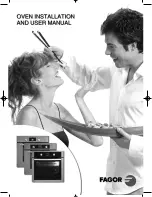
- 15 -
Cooking Instructions
Cookware
1. Heat-proof glassware, such as Pyroceram
®
and
Pyrex
®
, is best suited for use in the microwave
oven.
2. Do not use metal ware, ceramics trimmed with gold
or silver, or any container with a metal content.
3. If “arcing” should occur, check the cookware
carefully again for metal.
4. You may use ordinally glassware, chinaware,
plastic-ware and paper-ware, when cooking food
that requires a low temperature. Using this type of
cookware for high temperature cooking may cause
cracking or warping.
5. You can cook steamed vegetables in special “see-
through” wrapping
fi
lm, such as Saran Wrap
®
, or
wax paper. Do not cook in a plastic bag.
CAUTION
Do not use METAL UTENSILS in this oven.
Defrosting Frozen Foods
1. If you try to completely defrost frozen foods in the
microwave oven, uneven defrosting may occur due
to the differences in the thickness and shape of the
food. Drippings may also result, and sometimes
a part of the food cooks although other parts still
remain frozen. In actual usage of frozen foods,
you should not normally defrost them 100%. 70%
defrosting in the microwave oven is ideal and
helpful for the next cooking operation.
2. To defrost evenly, turn over or rearrange the food
during defrosting.
3. To defrost fatty meat, heat it in the microwave
oven for a short time and leave it to stand at room
temperature, or heat it intermittently until defrosted.
4. When you defrost a whole chicken, or any frozen
food of irregular shape, wrap legs or thin parts with
aluminum foil. Otherwise thin parts will be defrosted
faster and sometimes cooked before other parts
have properly defrosted. For big pieces of meat,
wrap the sides with aluminum foil so that they will
be uniformly thawed by vertical microwaves only.
5. Ice should be removed at times during defrosting.
Other Helpful Instructions
FOR BEST RESULTS
1. When determining time for particular foods, always
fi
gure minimum time and check occasionally during
cooking for progress. The microwave oven cooks
so quickly, therefore it is easy to overcook your
foods.
2. Be careful of the cooking time for small quantities
of foods, or foods with low water content. They may
burn if cooked too long.
3. Do not use the oven for drying kitchen towels or
napkins. They may burn if heated too long.
4. Do not try to boil eggs in the oven.
5. When you cook an egg be sure to pierce the yolk
membrane prior to placing into the oven to prevent
the egg bursting.
HOW TO GET BROWNED FINISH
Generally foods do not brown when cooked by a
microwave oven. This is one of the features of the
equipment. To brown chickens, brush sauce on the
surface before or during cooking. You can also brown
meat in a conventional frying pan before cooking in the
oven. A browning skillet for the microwave oven can
obtain the same result.
FOR EVEN FINISHED COOKING
Open the door and give the dish a half turn, or turn the
food over during cooking. This helps to achieve more
even cooking. When you cook chicken the legs cook
faster than other parts. Wrap the legs with aluminum
foil during cooking to re
fl
ect the microwave energy in
order to create even cooking.
Standing Time
Standing time refers to the period at the end of cooking
or reheating when food is left before being eaten, i.e.
it is a rest time which allows the heat in the food to
continue to conduct to the centre, thus eliminating cold
spots.
F0003BS90QP_Eng_00_20150722.indd Sec1:15
F0003BS90QP_Eng_00_20150722.indd Sec1:15
2015/7/22 9:46:02
2015/7/22 9:46:02






































